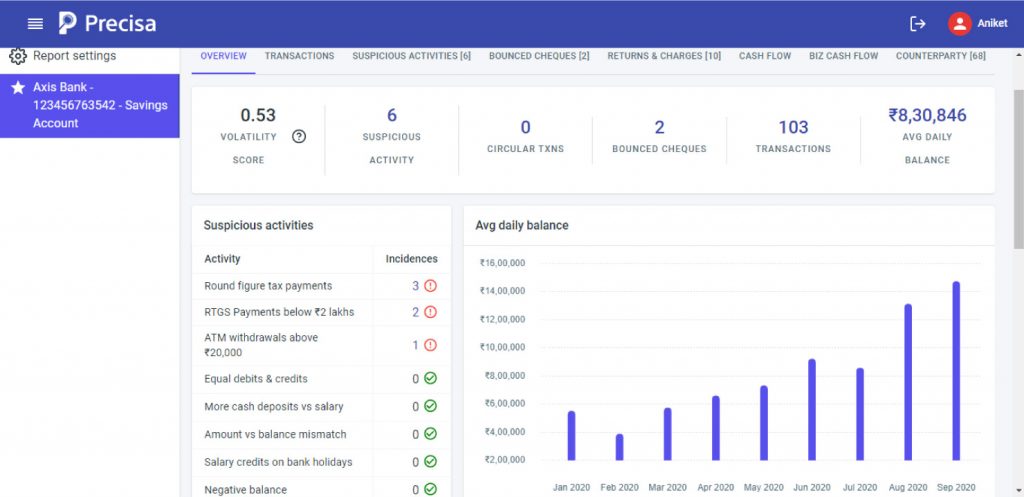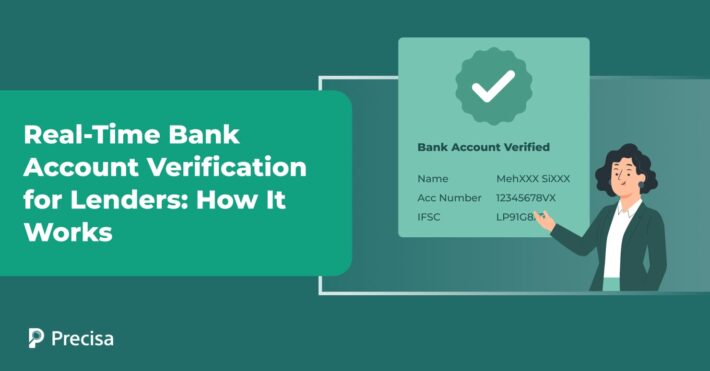Bank Account Research for Cash Flow-Based Lending: Tracking Everything

For banks and Non-Banking Financial Companies (NBFCs), lending is one of the key business areas. Lending is perhaps their primary source of revenue and also the most profitable. In recent years, the lending process has also become a lot easier, resulting in a surge in the number of borrowers from all sectors and divisions.
With the increase in the number of borrowers, the number of payment defaulters has also increased proportionately. This has forced the lending institutions to employ more resources to validate the authenticity of the borrowers during the onboarding and KYC stage. Among all the documents collected during the loan application stage, the customer’s bank statement is one of the most important documents.
As we all know, bank statements are a good indicator of an individual’s spending patterns, expenses, and most importantly, one’s income. The banks and NBFCs use these statements to decide on the creditworthiness of the borrowers. But since the bank statements typically run for pages and pages, deciding on the borrowers’ worth requires a lot of analysis. In most cases, the analysis is done manually by employing hundreds of people.
This is very cumbersome and also prone to errors. That’s where advanced intelligent technology tools like bank statement analysers or bank statement analysis engines can come to the rescue.
Key Things to Track During Bank Statement Analysis
Below are some of the key aspects that a good bank statement analyser needs to track:
1. Transaction Pattern Analysis:
a. High Valued Transactions
The Bank Statement Analysis (BSA) engine should be able to spot and highlight the high-valued transactions alone separately based on a configurable value limit. Typically, in the case of a high net worth borrower, many high-value transactions are expected. But, in case a normal borrower has a large number of high-value transactions, the engine should buzz an alarm.
b. Daily/Monthly Closing Balances
Closing balances play a critical part in understanding the consistency in the financial pattern of a borrower. For instance, the BSA engine can analyse the daily closing balance data and highlight how many days in a month the closing balance is more than two standard deviations from the mean. This validation range should also be configurable so that the engine can apply the rule with different limits for different borrowers.
c. Debit/Credit Analysis
The number of credits and debits in an account is a good indicator of one’s income and expense and gives a clear demonstration of one’s different income sources. The BSA engine should be able to provide a clear summary of the credits and debits and high light in case of any abnormal pattern based on the rules set in the engine.
d. Income Accounting
Not all credits can be considered as income. A good BSA engine should have a definite rule to identify the income alone, especially when the potential borrower is a salaried employee.
e. OD/CC Utilisation Analysis
The BSA engine should be able to analyse the OverDraft / Cash Credit limit based on the stipulated sanction limit entered by the user and the sum and max of the actual utilisation amount.
f. Recurring Payments and Deposits:
BSA engine should be able to highlight the recurring payments since it gives more details about the long term commitments of the borrower. Similarly, recurring deposits is healthy information that shows a consistent flow of income. This should be highlighted as a positive by the BSA engine.
g. Counterparty Transactions
The Bank Statement Analysis should be able to highlight the benefactors and recipients of the user’s business. This should have two sections—one highlighting the credit transaction details and another highlighting the debit transaction details.
h. Loan Related Payments
The BSA should highlight all the loan-related repayment statuses separately. This will give a good view of the borrowers’ liabilities.
2. Charges and Returns Analysis:
a. Charges
The BSA should be able to identify and highlight all the charges like charges on cheque returns, costs for not maintaining a minimum balance, charges on forex conversions, invoices on any pre closures of deposits, charges on delayed payments, charges due to insufficient funds on recurring payments, etc.
b. Cheque Returns
Cheque returns attract heavy penalties and can also raise questions on the financial credibility of the cheque issuer. Depending on the amount involved and the impact on the receiver, cheque returns can also incur legal actions. The BSA engine should be able to do a thorough analysis of all the cheques issued and their realisation details to identify and highlight any returns.
3. Fraud / Anti-Money Laundering (AML) Analysis:
a. Multiple Small Credits
If there are a large number of small credits from different and new sources to a single account, it is a potential case of money laundering. The Bank Statement Analysis engine should be able to identify such patterns for further investigation.
b. Suspicious Transactions
Any suspicious or potentially fraudulent activities that indicate poor creditworthiness needs to be flagged by the BSA engine. This can include transactions such as more cash deposits vs. salary, negative balance transactions, salary or cheque deposits on holidays, dubious tax payments, high ATM withdrawals, etc.
c. Circular Transactions
Circular transactions are a kind of artificial transaction between companies under a single group or a single controller. Usually, circular transactions are done to inflate the income or expense of the companies involved. This practice is legally considered a scam and is banned in several countries. The BSA should be able to identify and flag such transactions, especially in the case of business borrowers.
d. Multiple Cash Deposits
In the case of retail borrowers, frequent and many cash deposits other than salary is a clear indication of suspicion. BSA engine should be able to identify this pattern and flag such transactions
Besides, the BSA engine should have real-time integration with GST and credit bureaus to acquire the latest details on the borrowers’ credit history.
The aggregate output of all the analysis should result in a creditworthiness score of the borrowers that will act as a guiding light.
Having a robust bank statement analysis engine that does a thorough parsing of the borrowers’ bank statements and highlights all the necessary details will help the lending institutions make informed decisions while granting loans and reducing the NPAs.
Precisa, an affordable, intuitive and cutting-edge analytics software, can help your financial institution democratise bank statement analysis in the areas of cash flow-based lending, wealth management, and insurance. This will empower you with key insights to streamline the underwriting process and make data-driven decisions with minimal efforts.



